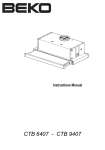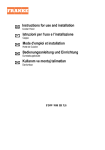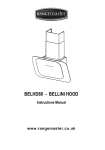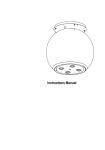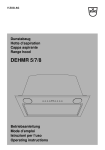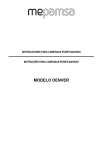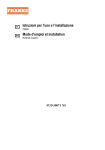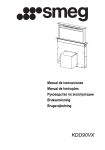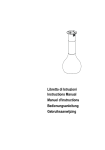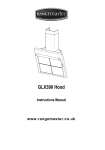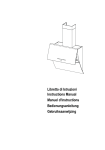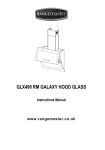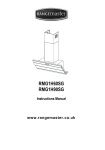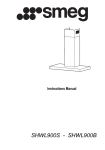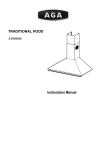Download Rangemaster OPLHD100
Transcript
OPLHD60 – OPLHD90 – OPLHD100 –
OPAL HOOD
Instructions Manual
www.rangemaster.co.uk
INDEX
EN
RECOMMENDATIONS AND SUGGESTIONS ..................................................................................................................... 3
CHARACTERISTICS ............................................................................................................................................................. 4
INSTALLATION...................................................................................................................................................................... 5
USE ........................................................................................................................................................................................ 8
MAINTENANCE ..................................................................................................................................................................... 9
2
2
RECOMMENDATIONS AND SUGGESTIONS
The Instructions for Use apply to several versions of this appliance. Accordingly, you may find
descriptions of individual features that do not apply to your specific appliance.
INSTALLATION
• The manufacturer will not be held liable for any damages resulting from incorrect or improper
installation.
• The minimum safety distance between the cooker top and the extractor hood is 650 mm (some
models can be installed at a lower height, please refer to the paragraphs on working dimensions
and installation).
• Check that the mains voltage corresponds to that indicated on the rating plate fixed to the inside of
the hood.
• For Class I appliances, check that the domestic power supply guarantees adequate earthing.
Connect the extractor to the exhaust flue through a pipe of minimum diameter 120 mm. The route
of the flue must be as short as possible.
• Do not connect the extractor hood to exhaust ducts carrying combustion fumes (boilers, fireplaces,
etc.).
• If the extractor is used in conjunction with non-electrical appliances (e.g. gas burning appliances), a
sufficient degree of aeration must be guaranteed in the room in order to prevent the backflow of
exhaust gas. The kitchen must have an opening communicating directly with the open air in order
to guarantee the entry of clean air. When the cooker hood is used in conjunction with appliances
supplied with energy other than electric, the negative pressure in the room must not exceed 0,04
mbar to prevent fumes being drawn back into the room by the cooker hood.
• In the event of damage to the power cable, it must be replaced by the manufacturer or by the
technical service department, in order to prevent any risks.
• If the instructions for installation for the gas hob specify a greater distance specified above, this has
to be taken into account. Regulations concerning the discharge of air have to be fulfilled.
2°
USE
•
•
•
•
•
•
•
•
•
The extractor hood has been designed exclusively for domestic use to eliminate kitchen smells.
Never use the hood for purposes other than for which it has been designed.
Never leave high naked flames under the hood when it is in operation.
Adjust the flame intensity to direct it onto the bottom of the pan only, making sure that it does not
engulf the sides.
Deep fat fryers must be continuously monitored during use: overheated oil can burst into flames.
Do not flambè under the range hood; risk of fire
This appliance is not intended for use by persons (including children) with reduced physical, sensory or mental capabilities, or lack of experience and knowledge, unless they have been given supervision or instruction concerning use of the appliance by a person responsible for their safety.
Children should be supervised to ensure that they do not play with the appliance.
“ CAUTION: Accessible parts may become hot when used with cooking appliances.”.
MAINTENANCE
• Switch off or unplug the appliance from the mains supply before carrying out any maintenance
work.
• Clean and/or replace the Filters after the specified time period (Fire hazard).
• Clean the hood using a damp cloth and a neutral liquid detergent.
The symbol
on the product or on its packaging indicates that this product may not be treated as household waste. Instead it shall be handed over to the
applicable collection point for the recycling of electrical and electronic equipment. By ensuring this product is disposed of correctly, you will help prevent potential negative
consequences for the environment and human health, which could otherwise be caused by inappropriate waste handling of this product. For more detailed information
about recycling of this product, please contact your local city office, your household waste disposal service or the shop where you purchased the product.
EN
3
3
CHARACTERISTICS
Dimensions
0
300
330
380
Min. 330 - Max. 640
20
Components
Ref.
1
Q.ty Product Components
1 Hood Body, complete with: Controls, Light, Blower,
Filters
2.1
1 Upper Section
2.2
1 Lower Section
8
1 Directional Air Outlet grille
9
1 Reducer Flange ø 150 – 120 mm
10
1 Adapting ring ø 120-125 mm
15
1 Angle iron
16
1 Filter cover
Ref. Q.ty Installation Components
7.2.1
2 Upper Chimney Section Fixing Brackets
11
6 Wall Plugs
11a
2 Wall Plugs SB 12/10
12a
6 Screws 4,2 x 44,4
12c
10 Screws 2,9 x 6,5
12d
6 Screws 2,9 x 9,5
Q.ty Documentation
1
Instruction Manual
EN
5
4
4
INSTALLATION
Wall drilling and bracket fixing
1÷2
540
2
140 140
1
2
788
11
164 164
450
1
11a
12a
X
7.2.1
As a first step, proceed with the following drawings:
• a vertical line up to the ceiling or up to the upper limit, at the centre of the area in which the
hood is to be fitted;
• a horizontal line at a minimum 788 mm above the cooker top.
• Mark a point (1) on the horizontal line, 164 mm to the right of the vertical reference line.
• Repeat this operation on the other side, checking that the two marks are levelled.
• Mark a reference point (2) as indicated at 140 mm from the vertical reference line and 540
mm above the cooker top.
• Repeat this operation on the other side, checking that the two marks are levelled.
• Drill at the marked points (1), using a ø 12 mm drill bit.
• Drill at the marked points (2) using a ø 8 mm drill bit.
• Insert the bracket plugs 11a into the holes (1) and tighten the screws.
• Insert plug 11 into holes (2).
To install a decorative chimney ( optional )
• Place bracket 7.2.1 on the wall, about 1-2 mm from the ceiling or from the upper limit,
aligning the centre (notch) with the vertical reference line.
• Mark the wall at the centres of the bracket holes.
• Place the bracket 7.2.1 on the wall at X mm below the first bracket (X = height of the upper
chimney section), aligning the centre (notch) with the vertical line.
• Mark the wall at the centres of the bracket holes.
• Drill ø 8 mm holes at all the marked centre points.
• Insert the wall plugs 11 in the holes.
• Fix the brackets using the 12a screws (4,2 x 44,4) supplied with the hood.
EN
5
5
Fitting the hood body
• Open the doors/the door (See section Open Panels).
• Remove the Metal grease filters using the handles
provided.
• Adjust the two screws Vr, in the brackets 11a, so that
they are at the start of their travel.
• Hook the hood body to the two brackets 11a.
• From the inside of the hood body, turn screws Vr to
level the hood body itself.
• Fasten the safety screw 12a.
• Close the doors/the door again.
11a
Vr
12a
Connections
DUCTED VERSION AIR EXHAUST SYSTEM
When installing the ducted version, connect the hood to
the chimney using either a flexible or rigid pipe ø 150
or 125 mm, the choice of which is left to the installer.
• To install a ø 125 mm air exhaust connection, insert
the reducer flange 9 on the hood body air outlet and
the adapting ring ø120-125 10 on the reducer flange.
• Fix the pipe in position using sufficient pipe clamps
(not supplied).
• Remove any activated charcoal filters.
EN
ø 150
9
ø 125
10
6
6
Recirculation Version Air Outlet
To install the Recirculation Version of the hood, the Activated
charcoal filter must be fitted, see paragraph “ Activated charcoal
filter (Recirculation version)”.
8
12d
12c
16
• Screw the filter cover onto the air outlet, using four screws 12c
(2.9 x 12.5).
• Fix the directional grille 8 on the recirculation air outlet using
the 2 screws 12d (2,9 x 9,5) provided.
ELECTRICAL CONNECTION
• Connect the hood to the mains through a two-pole switch having a contact gap of at least 3 mm.
• Remove the grease filters (see paragraph Maintenance) being
sure that the connector of the feeding cable is correctly inserted in the socket placed on the side of the fan.
Flue assembly
The chimney can only be installed with exhausting hood
• Fasten the angle iron 15 to the hood canopy using the screws
12d (2,9 x 9,5) provided.
Upper exhaust flue
• Slightly widen the two sides of the upper flue and hook them
behind the brackets 7.2.1, making sure that they are well
seated.
• Secure the sides to the brackets using the 4 screws 12c (2,9 x
6,5) supplied.
Lower exhaust flue
• Slightly widen the two sides of the flue and hook them between the upper flue and the wall, making sure that they are
well seated.
• Fix the lower part laterally to the hood body using the 2 screws
12c (2,9 x 6,5) supplied.
EN
7
7
USE
Control panel
T1
Button
T1
T2
T3
T4
L
EN
T2
T3
Function
Turns the Motor off.
Turns the motor on at speed one
Turns the Motor on at speed two
Press and hold for 2 seconds to enable
shutdown with a 20 minute delay (Motor+Lights). It is possible to change the operating speed when this function is enabled.
Turns the Motor on at speed three
Press and hold for 2 seconds to activate
Intensive speed, which is timed to run for
10 minutes. At the end of this time it will
automatically return to the speed set before.
Suitable to deal with maximum levels of
cooking fumes.
Turns the Lighting System on and off at
maximum intensity.
T4
L
Buttons T1+T2 are on.
Buttons T1+T3 are on.
The respective buttons T1+
(T2 or T3 or T4) will flash.
Buttons T1+T4 are on.
The button flashes.
Button on
8
8
MAINTENANCE
Opening Panel
•
•
•
•
Open the Panel by pulling it.
The panel can be locked in any position.
Clean the outside with a damp cloth and neutral detergent.
Clean the inside using a damp cloth and neutral detergent; do
not use wet cloths or sponges, or jets of water; do not use
abrasive substances.
Grease filters
CLEANING METAL SELF- SUPPORTING GREASE FILTERS
• The filters must be cleaned every 2 months of operation, or
more frequently for particularly heavy usage, and can be
washed in a dishwasher.
• Pull the comfort panels to open them.
• Remove the filters one by one pushing them towards the back
side of the hood unit and simultaneously pulling downwards.
• Any kind of bending of the filters has to be avoided when
washing them. Before fitting them again into the hood make
sure that they are completely dry. (The colour of the filter surface may change throughout the time but this has no influence
to the filter efficiency).
• When fitting the filters into the hood pay attention that they are
mounted in correct position the handle facing outwards.
• Close the comfort panel.
EN
9
9
Activated charcoal filter (Recirculation version)
A
These filters are not washable and cannot be regenerated, and
must be replaced approximately every 4 months of operation, or
more frequently with heavy usage.
•
•
•
•
•
•
REPLACING THE ACTIVATED CHARCOAL FILTER
Open the comfort panels pulling them downwards.
Remove the metal grease filters
Remove the saturated activated charcoal filter as shown (A).
Fit the new filters (B).
Replace the metal grease filters.
Close the comfort panels.
B
Lighting unit
Warning: This appliance is fitted with a white LED lamp classed
as 1M according to EN 60825-1: 1994 + A1:2002 + A2:2001
standards; maximum optical power emitted @439nm: 7µW. Do
not look directly at the light through optical devices (binoculars,
magnifying glasses…).
• For replacement contact technical support. ("To purchase contact technical support")
EN
1
10
AGA RANGEMASTER GROUP PLC
991.0301.958_ver4












